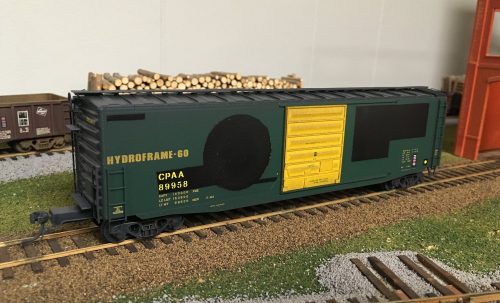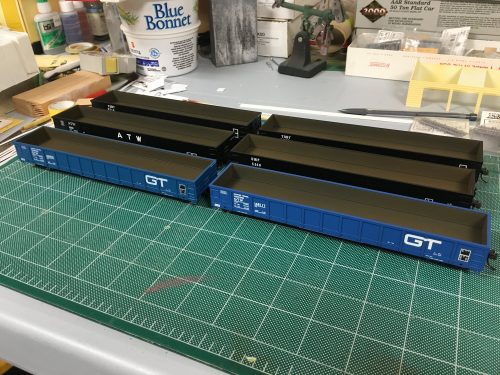
CP 80967 is a simple study in very minor paint and decal tweaks to update the appearance of a (basically) RTR car.
The subject is a factory decorated model originally produced by Life Like under the Proto1000 brand label. (This tooling is now owned by Walthers.) It’s basically Ready to Run, other than the ladders and door rods being modeler-applied parts although they don’t really take any special skill to install.
One thing about the model is the colour of the roof. The roof is factory painted a pale grey colour to represent a bare galvanized steel roof, but just being a flat grey fails to really “pop” properly. So to improve the car (actually a trio of cars I have in these colours) I masked off the roof and re-sprayed it with Model Master “Steel”. The overall colour is almost the same shade except the Steel actually gives it a proper metallic finish. Next, as the 80967-81216 (yep, this car is actually the “class unit” for the series) were delivered in 1967 and actually originally painted in script, the Action Green MultiMark represents a repaint of these cars, and a little bit of Action Green overspray was added around the edges.
Standard decal additions of COTS and U-1 stencils in varying locations on the different cars and updated weigh dates completes the standard lettering updates before weathering.
One really neat feature of this model also needs to be addressed here. Life Like tooled two body version with different styles of plug doors – an inside-post (flush appearance) as shown on this car, and an exterior-post (recessed appearance). The interior post doors were on cars built up to 1968, and cars built 1969 or after had the exterior post doors. Another key difference between the earlier and later cars was the wheelbase, with cars built up to 1967 having a shorter 38’10” length between truck centres, and cars built 1968 and later have a longer 40’8″ truck centre distance. The model does something super clever here that a lot of people may not even be aware of – the truck bolsters are actually separate pieces that can be removed, rotated 180 degrees and reinstalled to shorten the wheelbase. (The truck centres should be narrowed on this car, but I took the photo before addressing the trucks.)
A roster of prototype cars that match the models, with door and wheelbase information:
| Series |
Date |
Door |
Wheelbase |
UF |
Notes |
| CN 401483-401882 |
12/66-1/67 |
YPD |
38’10” |
C |
|
| CN 400600-400999 |
1-3/67 |
YPD |
38’10” |
C |
|
| CP 80967-81216 |
4/67 |
YPD |
38’10” |
C |
|
| QNSL 1670-1679 |
5/67 |
CPD |
38’10” |
C |
|
| PGE 4601-4642 |
5/67 |
YPD |
38’10” |
U |
re# BCOL 4601-4642 |
| CN 400350-400599 |
6-7/68 |
YPD |
40’8″ |
C |
re# CNIS 400350-400599 /70 |
| DWC 403000-403149 |
1-2/69 |
YPDX |
40’8″ |
C |
|
| CVC 402000-402499 |
2-4/69 |
YPDX |
40’8″ |
C |
|
| PGE 4651-4750 |
4/69 |
YPDX |
40’8″ |
U |
re# BCOL 4651-4750 |
| CPI 85000-85499 |
5-7/69 |
YPDX |
40’8″ |
C |
re# CP 85000-85499 |
| MDW 7001-7099 |
7/69 |
YPDX |
40’8″ |
C |
re# CPAA 86000-86099 /88 |
Door: YPD = interior post (flush) Youngstown plug door, YPDX = exterior post (recessed) Youngstown plug door, CPD = interior post Camel plug door.
Underframe (UF): C = HydraCushion cushioned underframe, U = rigid underframe





